Archive for May, 2013
» posted on Tuesday, May 7th, 2013 by Linda Lou Burton
Rock Solid
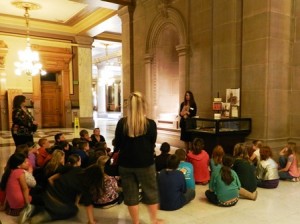 Linda Burton posting from Indianapolis, Indiana – “I know you are very smart,” the tour guide said, her lapel-mike echoing her voice in the great hall, “Your teachers are very good, and you have come here today to learn more about your state. I am proud of you.” “Rapt attention” may sound a bit clichéd, but the fourth-grade class circle-seated on the rotunda’s marble floor was seriously paying attention. I felt pretty smart myself, and right at home; there was something in the air, was it the light filtering through the colorful art-glass dome of the rotunda? Or the pleasant musty smell of the oaks doors facing the spacious hall – offices of the Governor, the Secretary of State, the
Linda Burton posting from Indianapolis, Indiana – “I know you are very smart,” the tour guide said, her lapel-mike echoing her voice in the great hall, “Your teachers are very good, and you have come here today to learn more about your state. I am proud of you.” “Rapt attention” may sound a bit clichéd, but the fourth-grade class circle-seated on the rotunda’s marble floor was seriously paying attention. I felt pretty smart myself, and right at home; there was something in the air, was it the light filtering through the colorful art-glass dome of the rotunda? Or the pleasant musty smell of the oaks doors facing the spacious hall – offices of the Governor, the Secretary of State, the  Treasurer – knock to come in, communicate. Upstairs, on the balcony, I passed a window-in-the-wall that allowed a view straight into the Senate chambers; a passing staff member explained – “We want people to know what’s going on. You can watch from the hallway or the gallery above.” No session today, but the Chamber doors were open; “You’re welcome to go in,” she urged, “And don’t miss the Supreme Court room.” I followed her suggestion, noting the “Activities For Kids” bulletin board just outside the Supreme Court door. Inside I settled in a wooden chair to rest a moment and opened the booklet I’d picked up at the Visitors Desk. I read the chapter titles first: A Center of Civic Life. In Character With The Parthenon. In Clear Arrangement. The First One Hundred Years. Restoration At Its Best. A Solid Foundation. I flipped to the last sentence on the last page: “Indiana’s State House has a rock-solid foundation.” My interest was thoroughly piqued by now, I decided to begin at the beginning. » read more
Treasurer – knock to come in, communicate. Upstairs, on the balcony, I passed a window-in-the-wall that allowed a view straight into the Senate chambers; a passing staff member explained – “We want people to know what’s going on. You can watch from the hallway or the gallery above.” No session today, but the Chamber doors were open; “You’re welcome to go in,” she urged, “And don’t miss the Supreme Court room.” I followed her suggestion, noting the “Activities For Kids” bulletin board just outside the Supreme Court door. Inside I settled in a wooden chair to rest a moment and opened the booklet I’d picked up at the Visitors Desk. I read the chapter titles first: A Center of Civic Life. In Character With The Parthenon. In Clear Arrangement. The First One Hundred Years. Restoration At Its Best. A Solid Foundation. I flipped to the last sentence on the last page: “Indiana’s State House has a rock-solid foundation.” My interest was thoroughly piqued by now, I decided to begin at the beginning. » read more
» posted on Friday, May 3rd, 2013 by Linda Lou Burton
Two Hoosier Guys
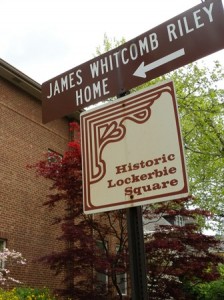 Linda Burton posting from Indianapolis, Indiana – An unopened letter under glass. A hat and cane on the bed. These lonely mementos are remnants of the lives of two men whose words have touched virtually every school child and avid reader of the last hundred years. I’m talking about James Whitcomb Riley (1849-1916) and Kurt Vonnegut Jr (1922-2007), both with inextricable ties to Indianapolis. Riley was an American writer known as the Hoosier Poet. His work tended to be humorous or sentimental and most of the thousand poems he published were in dialect, like Little Orphant Annie (1885). Vonnegut was an American writer known for his unique blend of satire and science fiction. His black comic voice became his trademark in novels such as Slaughterhouse Five (1969). The James Whitcomb Riley Museum Home and the Kurt Vonnegut Memorial Library sit only blocks apart in downtown Indianapolis. I visited both today, looking for more personal glimpses of the men and hoping to better understand what led them down their
Linda Burton posting from Indianapolis, Indiana – An unopened letter under glass. A hat and cane on the bed. These lonely mementos are remnants of the lives of two men whose words have touched virtually every school child and avid reader of the last hundred years. I’m talking about James Whitcomb Riley (1849-1916) and Kurt Vonnegut Jr (1922-2007), both with inextricable ties to Indianapolis. Riley was an American writer known as the Hoosier Poet. His work tended to be humorous or sentimental and most of the thousand poems he published were in dialect, like Little Orphant Annie (1885). Vonnegut was an American writer known for his unique blend of satire and science fiction. His black comic voice became his trademark in novels such as Slaughterhouse Five (1969). The James Whitcomb Riley Museum Home and the Kurt Vonnegut Memorial Library sit only blocks apart in downtown Indianapolis. I visited both today, looking for more personal glimpses of the men and hoping to better understand what led them down their 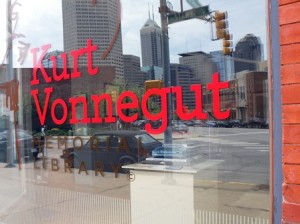 chosen paths. I never thought of them as anything alike, but before the day was over, I found that I was wrong; they had a great deal in common. Though born in different centuries, they grew up on Indiana time; little boys raised with Indiana values. As with most of us, they were greatly influenced by their families. James was the third of the six children of Reuben and Elizabeth Riley; Kurt Jr was the youngest of three children born to Kurt and Edith Vonnegut. Both families suffered a traumatic change of circumstances that reflected forever in the writings, and behaviors, of these two men. » read more
chosen paths. I never thought of them as anything alike, but before the day was over, I found that I was wrong; they had a great deal in common. Though born in different centuries, they grew up on Indiana time; little boys raised with Indiana values. As with most of us, they were greatly influenced by their families. James was the third of the six children of Reuben and Elizabeth Riley; Kurt Jr was the youngest of three children born to Kurt and Edith Vonnegut. Both families suffered a traumatic change of circumstances that reflected forever in the writings, and behaviors, of these two men. » read more
» posted on Wednesday, May 1st, 2013 by Linda Lou Burton
Birth Of A Capital City
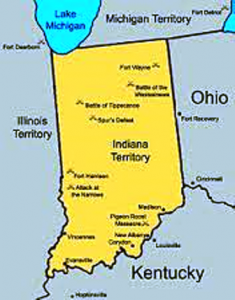 Linda Burton posting from Indianapolis, Indiana –How many capital cities have the name of the state within the name of the city? The answer is at the end of this post, but obviously Indianapolis is one. The name was created by joining “Indiana” with “polis,” which is the Greek word for “city.” Yes, Indianapolis literally means Indiana City (like Oklahoma City, a trivia hint for you). So the next question is “what does Indiana mean?” I won’t go into all of the Indian wars and treaties that occurred as the United States expanded westward; I’ll start with July 4, 1800, when Indiana Territory was pulled out of the larger Northwest Territory. Vincennes, a former French trading post and one of the only white settlements in the vast territory, was named capital. At that time about five thousand white Europeans lived north of the Ohio River; Native Americans
Linda Burton posting from Indianapolis, Indiana –How many capital cities have the name of the state within the name of the city? The answer is at the end of this post, but obviously Indianapolis is one. The name was created by joining “Indiana” with “polis,” which is the Greek word for “city.” Yes, Indianapolis literally means Indiana City (like Oklahoma City, a trivia hint for you). So the next question is “what does Indiana mean?” I won’t go into all of the Indian wars and treaties that occurred as the United States expanded westward; I’ll start with July 4, 1800, when Indiana Territory was pulled out of the larger Northwest Territory. Vincennes, a former French trading post and one of the only white settlements in the vast territory, was named capital. At that time about five thousand white Europeans lived north of the Ohio River; Native Americans 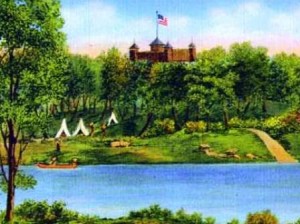 occupied most of the Territory, referred to as “Land of the Indians,” aka Indiana. Fast forward to December 1813: Corydon was named the second capital of Indiana Territory, and the wheels began to turn for statehood. President James Madison approved Indiana’s admission into the Union December 11, 1816 as the 19th state. The capital could not be located in the central part of the state at that time because the land was controlled by Native Americans; however in an 1818 treaty the area was opened for white settlement; an unprecedented migration followed. A central location for a capital city became imperative then; on January 11, 1820 Governor Jennings commissioned 10 men to select a site for the permanent capital. They chose a spot at the junction of Fall Creek and White River; the legislature ratified their selection January 6, 1821, and the building of a capital city began. Enter Alexander Ralston. » read more
occupied most of the Territory, referred to as “Land of the Indians,” aka Indiana. Fast forward to December 1813: Corydon was named the second capital of Indiana Territory, and the wheels began to turn for statehood. President James Madison approved Indiana’s admission into the Union December 11, 1816 as the 19th state. The capital could not be located in the central part of the state at that time because the land was controlled by Native Americans; however in an 1818 treaty the area was opened for white settlement; an unprecedented migration followed. A central location for a capital city became imperative then; on January 11, 1820 Governor Jennings commissioned 10 men to select a site for the permanent capital. They chose a spot at the junction of Fall Creek and White River; the legislature ratified their selection January 6, 1821, and the building of a capital city began. Enter Alexander Ralston. » read more
